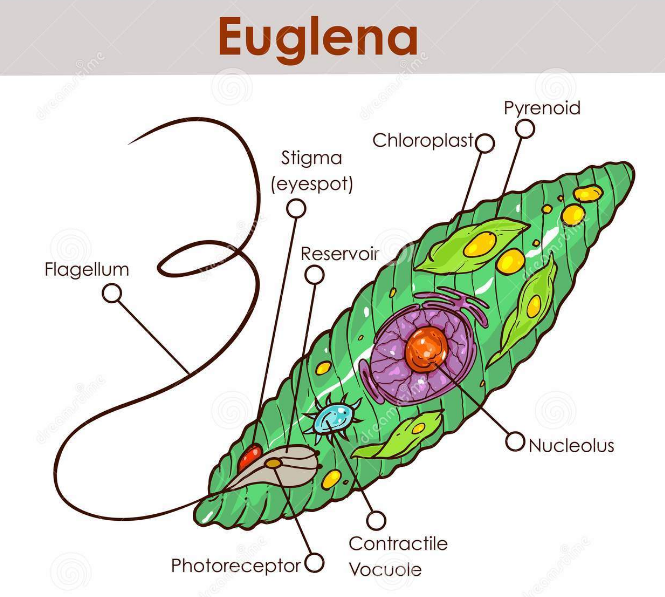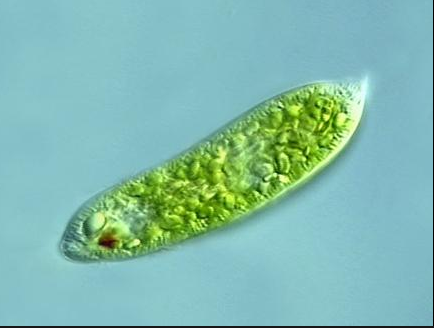Single-celled organisms, though often overlooked, play crucial roles in our ecosystems and offer profound insights into life’s complexity. Among these microorganisms, euglenoids and Euglena represent fascinating subjects due to their unique characteristics and biological behaviors. Their study not only sheds light on evolutionary biology but also on potential applications in science and industry.
Euglenoids are a diverse group of single-celled organisms found in freshwater and saltwater environments. A key member of this group is Euglena, which is notable for its ability to photosynthesize like plants, yet also consume food like animals. This dual capability makes Euglena both autotrophic and heterotrophic, setting it apart from its close relatives within the euglenoid family.
The significance of Euglena extends beyond its nutritional flexibility. As protists, Euglena exhibits features that are pivotal for understanding cellular processes and adaptations. Their impact on aquatic ecosystems, as well as their potential in biotechnological applications, highlights their importance in both ecological and economic contexts.

Defining Euglenoids
Characteristics of Euglenoids
Euglenoids are fascinating microorganisms that belong to the Protista kingdom. Typically, they inhabit a range of aquatic environments, including freshwater and brackish ecosystems. Their cellular structure is unique because it lacks a rigid cell wall. Instead, euglenoids are protected by a flexible outer layer called a pellicle. This pellicle allows them to change shape and move through their environment using a whiplike tail, or flagellum.
One of the most notable characteristics of euglenoids is their nutritional versatility. Many species can photosynthesize, thanks to chloroplasts that contain chlorophyll, much like plants. However, in the absence of light or when nutrients are scarce, some can switch to heterotrophy, absorbing nutrients directly from their environment. This dual capability makes them an integral part of their ecosystems, contributing both as primary producers and consumers.
Key Traits:
- Flexible pellicle
- Flagellar locomotion
- Dual nutritional modes (autotrophic and heterotrophic)
- Presence of chloroplasts for photosynthesis
Habitats and Ecology
Euglenoids are predominantly found in freshwater environments such as ponds, lakes, and slow-moving rivers where they play a crucial role in the ecological balance. They thrive in environments where organic material is abundant, including polluted waters, making them excellent indicators of water quality and environmental health.
Their ecological impact extends beyond mere existence; they influence the carbon cycle and contribute to the biomass of the habitats they populate. By engaging in photosynthesis, euglenoids help regulate atmospheric carbon dioxide levels and produce oxygen, benefiting other aquatic life forms.
Common Habitats:
- Freshwater ponds and lakes
- Brackish waters
- Polluted water bodies
Understanding Euglena
Euglena as a Type of Euglenoid
Euglena is one of the most well-known types of euglenoids. They are particularly distinguished by their green color due to the presence of chlorophyll. Like other euglenoids, Euglena uses a flagellum for movement but is exceptional for its photosynthetic capability, which is quite advanced among protists.
Unique Features of Euglena
Euglena stands out due to its eye spot, a light-sensitive organelle that helps it navigate toward light sources, optimizing its photosynthesis process. This ability to move toward light, known as phototaxis, is crucial for maximizing their energy production. Moreover, Euglena can survive in dark conditions by switching to heterotrophy, consuming organic matter from their environment, which adds to their adaptability.
Unique Features:
- Eye spot for light sensitivity
- Advanced phototaxis
- Versatile nutritional methods
Comparative Analysis
Structural Differences
When comparing Euglena with other euglenoids, structural differences are evident. Euglena typically has a more defined shape due to its intricate pellicle structure. The pellicle of Euglena consists of protein strips lying beneath the cell membrane, providing both flexibility and protection. This structure allows Euglena to undergo a unique twisting motion known as metaboly, which is not common in other euglenoids.
Nutritional Modes
The nutritional modes of Euglena are a significant point of comparison. While many euglenoids are capable of photosynthesis, Euglena’s ability to effortlessly switch between autotrophy and heterotrophy allows it to survive in various environments, from brightly lit waters to dark, nutrient-rich conditions. This flexibility is less pronounced in other euglenoids, which may rely more heavily on one form of nutrition over the other.
Reproduction and Lifecycle
Euglena reproduces asexually through binary fission, a process typical among euglenoids. The lifecycle of Euglena is relatively simple; it involves the cell elongating, its DNA replicating, and the cell splitting into two identical halves. This method of reproduction ensures rapid population growth under favorable conditions, allowing Euglena populations to adapt quickly to changes in their environment.
Ecological Impact
Role in Ecosystems
Euglenoids, particularly species like Euglena, have a significant role in aquatic ecosystems. As autotrophic organisms, they contribute to the primary production within their habitats by converting sunlight into energy through photosynthesis. This process not only aids in oxygen production but also provides a fundamental energy source for the aquatic food web.
Their role extends to acting as bioindicators. The presence and health of euglenoid populations can reflect the overall quality of water, indicating levels of pollution or nutrient availability. Their sensitivity to changes in their environment makes them crucial for ecological monitoring and assessments.
Key Roles:
- Primary producers in aquatic food webs
- Bioindicators of environmental health
Benefits and Challenges
The study and presence of euglenoids bring several benefits and challenges. Environmentally, they contribute to biodiversity and help stabilize the ecosystem functions. In research, their unique qualities offer insights into evolutionary biology and potential medical applications, such as in drug delivery systems due to their penetrative and adaptive cellular structures.
However, their adaptability can also lead to challenges, particularly in environments where nutrient pollution is high. In such cases, euglenoids can overpopulate, leading to algal blooms that may disrupt water habitats and decrease biodiversity by outcompeting other microorganisms.
Benefits:
- Stabilization of ecosystem functions
- Insights into cellular biology and evolutionary processes
Challenges:
- Potential to cause disruptive algal blooms
- Management and control in diverse environments
Scientific and Research Perspectives
Studies on Euglenoids
Scientific research on euglenoids has been extensive, focusing on their biology, ecology, and potential applications. These studies often explore the genetic makeup of euglenoids to understand their resilience and adaptability. Research has demonstrated that euglenoids exhibit a remarkable ability to adapt to various light conditions and nutrient availabilities, which could inform ecological theories on survival strategies and evolutionary adaptations.
In addition to ecological and evolutionary studies, research on euglenoids also delves into their cellular mechanisms. The unique properties of their pellicle and flagellar motion provide valuable models for studying cell structure and motility.
Euglena in Biotechnological Applications
Euglena’s capabilities extend into the realm of biotechnology, where their attributes are harnessed for innovative solutions. Their ability to produce biofuel is one of the most promising applications. Euglena can convert carbon into a form of bio-oil, a sustainable alternative to fossil fuels, which has drawn considerable interest from the energy sector.
Furthermore, their nutritional content, especially rich in vitamins and proteins, has prompted investigations into their use as a food supplement. This application could address malnutrition and provide a sustainable food source in areas where conventional agriculture is challenging.
In environmental management, Euglena is used in bioremediation projects to cleanse pollutants from water bodies. Their ability to absorb heavy metals and other contaminants can help restore the ecological balance in polluted environments.
Biotechnological Applications:
- Production of biofuels
- Nutritional supplements
- Bioremediation of polluted environments
Euglena and other euglenoids continue to be at the forefront of scientific research due to their complex biology and potential utility. Whether it is their ecological roles, their ability to indicate environmental health, or their applications in biotechnology, euglenoids offer a wide range of benefits and pose unique challenges that are essential for advancing our understanding of biology and enhancing our technological capabilities. Their ongoing study promises not only to enlighten us about the intricacies of life at the microscopic level but also to provide practical solutions to some of today’s most pressing environmental and technological challenges.
Frequently Asked Questions
What are Euglenoids?
Euglenoids are a group of single-celled, flagellate protists predominantly found in freshwater environments. They are most noted for their ability to thrive in a variety of environmental conditions due to their versatile metabolic systems.
How does Euglena photosynthesize?
Euglena photosynthesizes by using chloroplasts that contain the green pigment chlorophyll. This process is similar to that of plants, allowing Euglena to produce its own food by converting sunlight, carbon dioxide, and water into sugars, which fuel various cellular functions.
What distinguishes Euglena from other euglenoids?
Unlike other euglenoids, Euglena uniquely possesses the capability to switch between photosynthesis and heterotrophy, depending on the availability of sunlight and organic materials. This adaptability is facilitated by its complex cellular structure, which supports both light-dependent and light-independent nutritional methods.
Can Euglenoids survive in harsh conditions?
Yes, euglenoids are exceptionally resilient and can survive in harsh environmental conditions. They are equipped with a flexible pellicle instead of a rigid cell wall, allowing them to change shape and protect themselves against physical stresses and changes in their habitat.
Conclusion
In conclusion, the study of euglenoids, particularly Euglena, offers intriguing insights into the resilience and adaptability of life at the cellular level. These organisms bridge the gap between plant and animal kingdoms, demonstrating the fluidity of biological classifications and the interconnectedness of life forms.
The ongoing research into euglenoids and Euglena continues to uncover their potential in areas like biofuel production, waste-water treatment, and even space travel life support systems. Such studies not only deepen our understanding of biology but also pave the way for innovative solutions to environmental and technological challenges.

